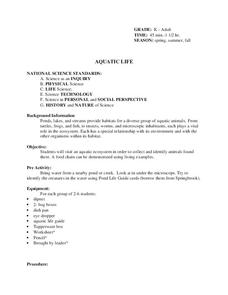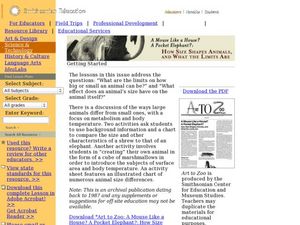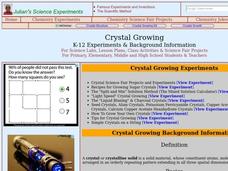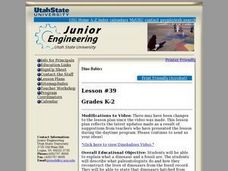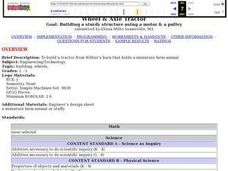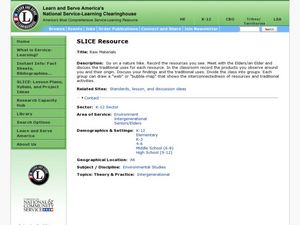Curated OER
2nd Grade Physical Sciences
Second graders complete activities to measure motion and learn about the Earth's history. In this motion and Earth history lesson, 2nd graders discuss sound and complete a matching sound activity. Students then study the history of Earth...
Curated OER
Flight Dreams - Flight Factors
Young scholars investigate the physics of flight by experimenting in class. In this history of flight lesson, students define terms such as gravity, lift, and drag in order to better understand how a plane is able to stay in the air....
Curated OER
Coal Flowers
Let's make coal flowers! With this fun activity, young learners watch and learn as they grow crystals! With simple household materials and the instructions included in this lesson plan, your class can grow their own crystals. Learners...
Curated OER
Exploring All Frontiers
Students utilize higher thinking skills to expand their self concept to include physical, cognitive, and affective frontiers. The teacher create activities which allow students to use raw data and primary sources, as well as...
Curated OER
Big Bones, Little Bones
Students investigate archeology. In this archeology lesson, students research the process of excavation. Students participate in a mock-excavation and sort objects by physical properties.
Curated OER
The Impact
Students see what inventors have to think about when making an invention. In this inventions lesson students examine Thomas Edison and the light bulb and the history of inventions.
Curated OER
Aquatic Life
Students explore aquatic life. In this science lesson, students visit an aquatic ecosystem and collect animals found there. Students create a food chain for the aquatic ecosystem.
Curated OER
Turtle Hurdles
Students explore physical education by researching biology. In this survival techniques activity, students discuss the methods turtles use to survive dangerous encounters and conduct a sea turtle role play exercise. Students identify the...
Curated OER
Classifying Shells
Students observe and classify different types of shells. They compare and contrast an exhibit they created with one that already exists in a musuem. They discover the different characteristics of shells.
National First Ladies' Library
A Blessing in Disguise
Young scholars study the history of polio as well as a history of modern medicine, the history of alternative medicine and the role of the scientific method in each of these histories. They review the scientific method and research...
Curated OER
Blast's Cosmic Carnival
Young scholars, after analyzing the history of a concentrator, model how a Genesis spacecraft concentrator works by playing a game. In groups of three or four, after being given materials to work with, are challenged to roll the rubber...
Curated OER
How Size Shapes Animals
Students investigate how size affects large and small animals differently. In this animal lesson plan, students determine how size affects different animals by constructing their own animal out of marshmallows. Once students create...
Curated OER
Crystal Growing
Students explore the different phases of a crystal. In this mineral instructional activity students grow their own sugar crystals using a sugar recipe.
Curated OER
The Magic School Bus Plays Ball
Students learn along with Ms. Frizzle's class. In this Magic School Bus lesson plan, students work in small groups to find how movement changes when there is more - and less - friction.
Curated OER
Who Has Seen the Wind?
Students investigate the characteristics of wind. In this weather lesson, students use poetry and van Gogh's paintings to discuss the movement of wind. Students are introduced to the Beaufort Scale and use the tool to measure the wind...
Curated OER
Lift and Drag: Principles of Flight and the Soaring Imagination
Students construct models of early gas balloons and gliders. In this balloon and glider lesson plan, students create models of early gas balloons and gliders, discover how the forces of lift and drag effect aircraft in flight, and put...
Curated OER
Wetlands: Pave or Save?
Students discuss the characteristics of wetlands and how to make them more productive. Using a map, they locate the major wetlands in the United States and color them using a key. They read an article and in groups answer discussion...
Curated OER
Water and Ice
Learners examine how water changes state, from a liquid to a solid. In this water lesson students study the water cycle and how temperature and pressure effect it.
Curated OER
Water and Ice
Students observe what happens to water as it goes from a solid to a liquid. In this exploratory lesson students gain an understanding for the water cycle while working in groups observing what happens to water as it changes state.
Curated OER
Dino Babies
Students distinguish between dinosaurs and fossils. They escribe what paleontologists do and how they reconstruct the lives of dinosaurs from the fossil record. In addition, they state that dinosaurs hatched from eggs.
Curated OER
Wheel & Axle Tractor
Students design and build a tractor using LEGO materials. They write and draw their designs.
Curated OER
Raw Materials
Students participate in a nature hike and record the natural resources observed. They compare traditional and modern versions of everyday use items, and create graphic organizers that demonstrate the interconnectedness of resources.








